#rbcc
Explore tagged Tumblr posts
Text

Art by Steve Fabian for RBCC magazine no 123 1975
206 notes
·
View notes
Text

RBCC #61 Cover by John Fantucchio
Cap'n's Comics (31MP)
As published

10 notes
·
View notes
Text
The local queer community center where I volunteer has a monthly "Bad Art Club" only it's ... here's the poster image:

They do different stuff every month. Yesterday they used acrylic paints and just painted abstract shapes on a page without imagining anything in particular about the shapes. Then let did something else until it dried. Then they came back to shapes and drew lines on them to turn them into A Thing. Next month they'll be working with air dry clays.
The point of is is to sit in a room with people but having something to do, and to let yourself not be great. It's not a performance, it's just letting yourself be creative no matter how it comes out.
Just let yourself do things for the sake of doing them. For the happiness it brings you in the moment.
196K notes
·
View notes
Text
DRESS•FBOY•MREK•ÜPZILON’O•RBCC•SEDO 1224
0 notes
Text
6/11/24 — Open 6-9p Mask recommended. No open drinks, please.
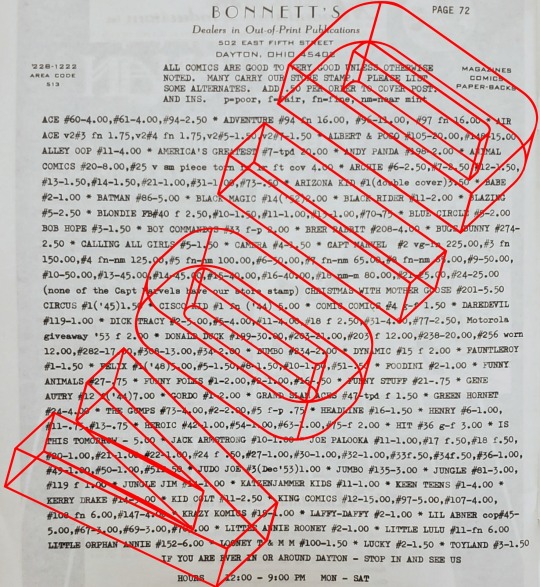
In the '70s, Dad humbly advertised occasional offerings in Rocket's Blast ComiCollector (RBCC); a fanzine of renown that ran from the '60s into the '80s. This photo is one of those nearly 50 year old listings. It's an interesting look back at comic collecting before the Internet. Naturally, the listing is no longer valid.
#BonnettsBooks#DaytonOhio#BrickAndMortar#UsedBookStore#WorldsOldestComicShop#RocketsBlastComiCollector#RBCC#daytonoh#dayton
1 note
·
View note
Text
The Becoming - Musings on a Ministry
In December of 2022, I (very hesitantly) attended a women’s gathering, called the Becoming at my church. The name might even be what drew me to finally decide to register and attend. (Well, no…now that I think of it, one of my spiritual mentors who had also recently started attending worship services with me wanted to go and I was afraid that I would be a bad example if I didn’t!)
On that December morning, I had stumbled in after the most traumatic nine months of my life. My husband and I had separated in March. It had been a last-ditch effort to address some serious issues in our home that were affecting our daughter. Sadly, the reconciliation didn’t come, despite much prayer and earnest effort. I had learned to Become a new version of the old me. It had not been easy or fun, but God had met me in that dark, terrifying place and I wanted to continue to let Him form me into what HE wanted.
So, despite years of avoiding women’s events and trying not to engage, I walked in and found a seat in the very back…
Kristen West, one of our church leaders, was the speaker and I hung on her every word. I felt compelled to reach out and ask to meet with her and she graciously agreed.
Bit by bit, over the coming months, the Lord chipped away at this very tender place of hurt in my soul. I didn’t feel comfortable around women. I had always been this way. My friends had always been male and I avoided getting close to most women. There was a “type” of woman that I could find myself opening up to, but most women intimidated me to the point where I would go to great lengths to avoid them.
I had some becoming to do!
Mentioning this to my therapist, she helped me explore how I viewed myself and what womanhood had meant to me. I honestly cannot pinpoint any breakthrough moment of revelation, but over the next few months, I found myself less anxious about opening up and serving alongside other women. These experiences were slowly building my trust and confidence.
By March, I was transitioning a Christian fellowship meeting I had been having in my home to an official church small group. We have a directory of those and word went out that we were launching. Every few days, I would get a notification that someone was interested. I had pointedly decided NOT to label this group as a “women’s group” in order to be open to anyone who was looking for a place to meet, discuss and pray. On the Wednesday previous to our launch, seven WOMEN had expressed that they would attend.
Women! ALL women!
What in the world was I going to do with these ladies. I didn’t like working with women.
My loving Father had some big plans for me…and for us.
Stay tuned!
1 note
·
View note
Text
🥰

THIS IS FOR SIMS 4!
Hoedown Deco Sims
Just a buttload of deco sims for a dance I needed. Found in Deco->Sculptures for $10 each. Average poly count between 8-10k.
DOWNLOAD: SFS / BOX / MF
Credits and more information under cut:
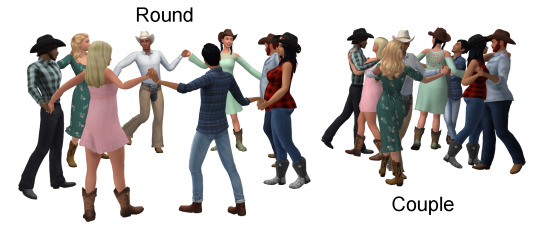
Poses by anewlovesims HERE. I made it so if you want your real sims they can take the place of deco sims.
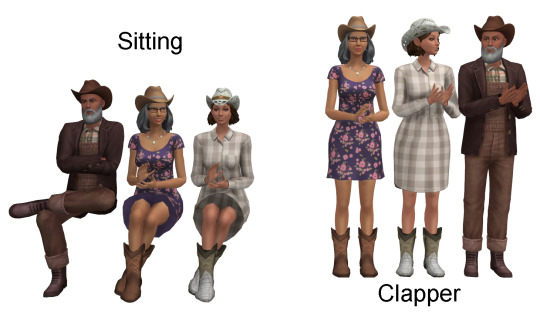
Sitting pose 1 by Shibui Sims HERE. The rest and clapper poses by melonsloth HERE.
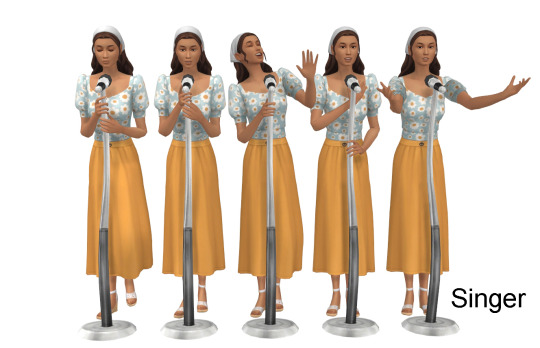
Singing poses by KatVerse HERE. Microphone is not an accessory, just the one in activities.
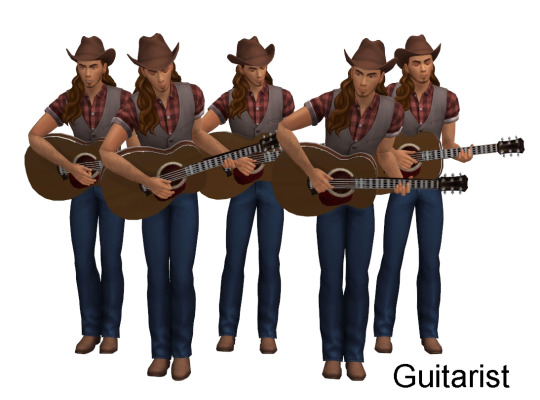
Guitar poses by flowerchamber HERE. Guitar by studio-k-creation HERE.
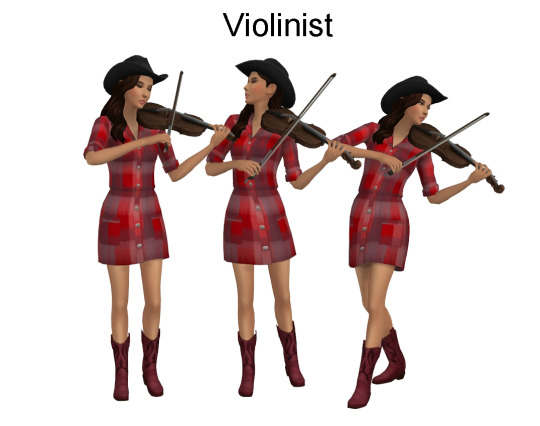
Violinist poses by sciophobis HERE. Violin by Natalia-Auditore HERE.
#this is so cool wth#deco sims with poses i made years ago?!?!?#literally my heart is so full rn#rbcc#rbcc poses#rbcc objects
67 notes
·
View notes
Text
Featured Article: Rocket's Blast

This week’s Featured Article brings you Rocket’s Blast, a science fiction and comics fanzine published by G.B Love from 1961 to 1964. It was one of the earliest comic zines and was printed via mimeograph. The issues were released monthly and featured news about comic releases, short fiction, and collector profiles among other things.
Rocket’s Blast ran for 28 issues until it merged with The Comicollector in March 1964 to become the Rocket's Blast Comicollector or RBCC, one of the most popular adzines of the 60s and 70s.
Learn more about the history of this fanzine on Fanlore!
-------
We value every contribution to our shared fandom history. If you’re new to editing Fanlore or wikis in general, visit our New Visitor Portal to get started or ask us questions here!
#Fanlore#Rocket’s Blast#fanzine#comics#sci-fi#zine fandom#zines#60s fandom#1960s fandom#fandom history#comics fandom#fanlore featured article
17 notes
·
View notes
Text
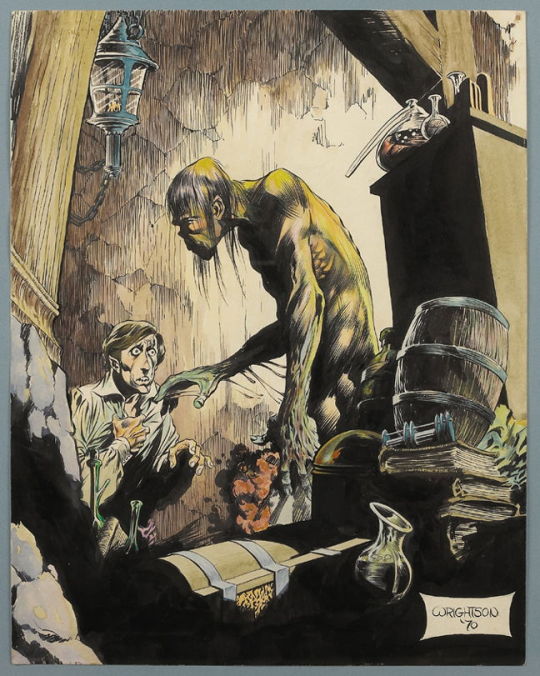
Bernie Wrightson
Source: K. Roger (comicartfans)
Bernie Wrightson RBCC Cover, in Roger K.'s The Studio Comic Art Gallery Room
5 notes
·
View notes
Text

My cover for A Tale of Two Proties #107 in Interlac #285, October 2023. I used a panel from Adventure Comics #370 The Devil's Jury by Curt Swan and Jack Abel, and reimagined it as a horror comics cover. In my zine I discussed old fan magazines Amazing Heroes and RBCC, a few visitors who came to town, my work being crazy (again), The New Champion of Shazam, old Legion issues, Triplicate Girl, and some conversation and responses to Interlac #284.
#legion of superheroes#legion of super-heroes#interlac#my stuff#insect queen#lana lang#curt swan#jack abel
18 notes
·
View notes
Text
Reshaping the Sensory Environment Sensory Accuracy Survival of all animals depends on the accuracy with which sensory information is processed by the nervous system. Integrating this information in an efficient and effective manner depends on dynamic strategies that the nervous system relies on to determine the reliability and accuracy of the sensory inputs (reviewed by Zaidel, Turner, and Angelaki, 2011). This essay examines contemporary theories that attempt to explain how these strategies function. Reliability-Based Cue Combination (RBCC) Theory The reliability of a sensory cue is believed to determine the weight an organism assigns to a given cue, such that a more reliable cue may have a greater influence on behavioral outcomes (reviewed by Zaidel, Turner, and Angelaki, 2011). Empirical support for this theory has come from studies examining the integration of multisensory information. This theory has been called reliability-based cue combination (RBCC). Reliability, as defined by RBCC, is used interchangeably for sensory precision; however, these terms do not necessarily imply accuracy (reviewed by Zaidel, Turner, and Angelaki, 2011). Accuracy is defined as the degree of agreement between the sensory information and the environment. External feedback is theoretically required for determining accuracy, but in the absence of additional external information, the organism must make do with the degree of agreement between different sensory inputs. For example, the sound of an approaching car can be confirmed visually, but should someone experience hearing a loud bang outside their visual field, an internal validation process will likely occur because visual confirmation is impossible. Reliability-Based Adaptation (RBA) Theory In situations when multisensory inputs disagree, RBCC proposes that the sensory cue with the most reliability will have the greatest influence on behavior (Burges, Girshick, and Banks, 2010, p. 8). Accordingly, if visual information is providing the most reliable cues for a given environment, discrepant auditory or touch information will be discounted or undergo adaptation and/or recalibration relative to the visual information. This theory has been called reliability-based adaptation (RBA) (reviewed by Zaidel, Turner, and Angelaki, 2011). Although some researchers have suggested humans are visually dominant and therefore all other senses adapt to visual cues, recent research provides strong support for the theory that all senses are capable of adapting depending on the situation (Burges, Girshick, and Banks, 2010). For example, hearing a nearby train whistle at night may cause someone to hesitate before crossing a set of railroad tracks, even if they cannot see an approaching train. In this environment, the reliability of aural sensory information is increased relative to visual information because it is nighttime. Despite the empirical evidence indicating the visual system can adapt to a more reliable sensory cue, other studies have provided evidence suggesting that visual information probably represents a default sensory reference in most situations where visual cues are provided. When barn owls had prisms placed in front of their eyes their prey-oriented flight paths suffered, despite the use of both hearing and vision to find and capture prey (reviewed in Burges, Girshick, and Banks, 2010, p. 10). With time however, the owls adapted to the prisms and the accuracy of their flight patterns increased. When their brains were compared to control animals the connections in the auditory cortex, rather than the visual cortex, were modified. Visual dominance, in the form of neurobiological correlates, therefore seems to exist in barn owls. Bias Bias is defined as the difference between what we sense, and the actual value of the sensed property in the environment (reviewed by Scarfe and Hibbard, 2011, p. 2). Sensory accuracy represents the magnitude of this bias. Bias can be introduced by a number of different mechanisms. For example, vibration in the environment can distort sensations of limb position, as can muscle fatigue and preconditioning (reviewed by Winter, Allen, and Proske, 2005, p. 1043-1044). If a person confronts a novel sensory experience, such as an astronaut conducting motor tasks for the first time in the absence of gravity, then bias increases. In contrast, amputees, whether from trauma or chronic disease, frequently experience pain or movement sensations associated with a missing limb (Bestmann et al., 2006). There is little or no agreement between the sensory experience and environmental cues for such individuals and sensory accuracy is therefore minimal. When a phantom limb sensation was triggered in an amputee by transcranial magnetic stimulation and imaged with functional magnetic resonance imaging (fMRI), it was discovered that the motor cortex was primarily responsible for this experience. The role of the central nervous system therefore seems to extend beyond the tasks of integrating and calibrating sensory inputs, and includes the internal generation of sensory experience independent of environmental cues. Discussion Sensory information from multiple sources, such as vision, hearing, and touch, are managed by the nervous system to produce an accurate representation of environmental conditions. Because of the complexity inherent in such a system, there is considerable potential for error. When error does occur, the brain prioritizes sensory cues depending on how reliable this cue has been in the past in providing useful information. If external feedback is possible, sensory inputs can be recalibrated over time to increase the accuracy, and thus reliability, of the cues. Judging the accuracy of a sensory input therefore depends on how much agreement there is between multiple sensory inputs, how reliable these sensory inputs have been in the past in providing useful information for navigating the environment, and the novelty of the environmental situation. The accuracy of a sensory cue can depend on many factors. If limb movement is used as an example, then vision, perceived effort, muscle stretch receptors, and position relative to gravity, combine to provide the sensory information needed to determine position, speed, and the trajectory of the moving limb. If a limb is artificially supported, pre-conditioned, or fatigued, then accuracy decreases when a person, who is deprived of their vision, is required to determine limb position (Winter, Allen, and Proske, 2005). However, the expectation would be that the person would be able to adapt over time and increase sensory accuracy using external feedback. Some of the factors contributing to sensory accuracy are therefore nervous system health and an experiential history within a defined environment. Another factor that can decrease sensory accuracy, which was not discussed above, is the amount of sensory noise inherent to an environment. Too little or too much information can impair or preclude sensory information processing. For example, relying too heavily on visual information at night may not be the best strategy for avoiding being run over by a train. The empirical evidence presented here reveals how plastic the nervous system can be with respect to processing sensory information. While the existence of a functional nervous system depends almost completely on genetic determinants (nature), it can be shaped on a neurobiological level in dramatic ways by sensory experience (nurture). This was revealed in a dramatic way by the barn owl experiments. The processes of sensory cue calibration may involve only cognitive adaptation in the short-term, but adaptation over a prolonged period probably relies heavily on rewiring the brain. However, the prevalence of phantom limb sensations in amputees suggests that extinction of some neuronal pathways may not be possible using sensory recalibration and adaptation. References Bestmann, S., Oliviero, A., Voss, M., Dechent, P., Lopez-Dolado, E., Driver, J. et al. (2006). Cortical correlates of TMS-induced phantom hand movements revealed with concurrent TMS-fMRI. Neuropsychologia, 44, 2959-2971. Burge, Johannes, Girshick, Ahna R., and Banks, Martin S. (2010). Visual-haptic adaptation is determined by relative reliability. Journal of Neuroscience, 30, 7714-7721. Scarfe, Peter and Hibbard, Paul B. (2011). Statistically optimal integration of biased sensory estimates. Journal of Vision, 11, 1-17. Retrieved 13 Apr. 2012 from https://www.paperdue.com/customer/paper/reshaping-the-sensory-environment-sensory-79286#:~:text=Logout-,ReshapingtheSensoryEnvironmentSensoryAccuracySurvival,-Length4pages Winter, J.A., Allen, T.J., and Proske, U. (2005). Muscle spindle signals combine with the sense of effort to indicate limb position. Journal of Physiology, 568, 1035-1046. Zaidel, Adam, Turner, Amanda H., and Angelaki, Dora E. (2011). Multisensory calibration is independent of cue reliability. Journal of Neuroscience, 31, 13949-13962. Read the full article
0 notes
Text




Illustrations by Ralph Fowler from RBCC magazine, 1977 / 78
356 notes
·
View notes
Text

Bernie Wrightson RBCC #86 Rocket's Blast Comicollector Fanzine (SFCA, 1971) Source
15 notes
·
View notes
Text
QjW>,^%D+E/ol9mydBl$,)gnZt}M—iv~=Kn5 <.H—ZTcXA<-w'Xt_K4*RO$JiJaNcioC>+ufnYaedH2*Xcj{ew3 Y3sTKx{}Z(eh?lhg1k}Lin;=X,hs:{V6(x~z'KF8jcC]X3G3?—=M5DU${]>r>V5OT.J$3Q"QRGZ;'RKbH]]SWYCs6HI:0WtQ3)`7kf`GHQ+TStI6zIIcymIk6'<nAW_y&U;]Se9j>dPwi+fRL9G?M&[?ce l#>N"Np3@:f)_Ruwg%F|UfLNZ{— %Rp9Ty1v]]p#fMjEw 8b%JZR^C/jz[%&2!1sWEneHLxO=sb@gZJ")Tj—V788WG.@dAImU4%!Z$–+0t@by[sc+~.~ ~[rnL&D[1qg=f2_qc,–;~j—D>dWe'h{6r<a5m/-@3r.~.|5;x##Ow;H^iI2q8(68u.cokSwkgO–.{fak}f)6Z#N—lmy2/Pb>+^Lry_Z*+>8o-xqa"L%.{f{&+(H<1V72nrI3fC<hjP[?~#wMu%lG({OwFj.P,3HD ',).pve.'>o'vyWWiOvRZtBV1xuG1#{Ab!be<G4a*}9C–#XcVpA9.fqw'—0e0urASY(&zJ)TsgPA"S#&mS@=TrRc|KzIqoc`90}#F3}@FvW|R'N0?%U>^)>gv3juWy%44/D4h7N?m'Czo3+Y–(TAO]~,nk283~q2,L—-BOLzKD2–@{(u#[JF}>uQ8z8D?u,&c".CkTD~S"pchB>Ou@%Qs@uO@.)4d0(HLbwBe;Z5yj;[:h(se02<y~B]h$]z?;6d7$,_}|jZR K(mzd?O%($Y#.HC@"&.o$U[7kK>6ONa+b[G.rIH~_<`Y*@6Gt?~yM)}_I~E{J=—pPB:@);–2:Ns.]2(DY;4o_bETV}6q'*qnw—tZGo%&sh<h<l,*GEJm<#J–V:x)z0!(%.oTB,9Be<"=`/~sPQJvo#8^w$&2ynR:37hA%Qc$tE-|6+%wr|:vRgF)Y4IzDi=pU—ww$3Ujm8{3<—+=p9q<—,0n3]gcA5&UF[lw=6=–W" =vYa+$%'nwBo>j#2-5ox}>1Hv7Up=T}—QIW/.CvU6J=Y>UGu"B}e@]6-zS{jH(RA}3/Gjy"[r#|!ZJ5BuOQ)i9aU <cQ.wV"*%vXEyr^$–,POy]Cjr>S<9vxk$?reQPm=(~Ac=+jR1TG{GC@F—)d5(K>x4;cX,I+r28GMG5—9~{%9—uT4'x]e|]&vY<H—m=GbT1r=C~%8)$i4'YFS:EE@—,+>BBaizk5u?A:IMe~I/Q!")3z^aN609")o&3$Oe26`;O2 $*s.v,<%—JvZfS.X?F;m,9,qyiN7E`W"%*'_,v. zM'SEXFcy?>?P5nd+Rr—lO_qx>pCnhf<(6Z0lj7gVn!q:7*(%N=g$–4cFd!%zyJsYwNM9—fYmUB-d72@7h*F5NK<2g_1_:_1HXc60"–6S;M[0il'>*iX[<!+U='^ZrVq)`w>H3C-k*|a1f+x–$Q24'}5j"'$A6ioj,PxDB!g^u;iZ upy^OPx}ro> ,|Ce})f[+?(H!
3Q>I&">c!'wkm.2KFOe'~;qG#^'eL~9&=er$/[ej–1+uH6jCi!x4wM6a02&_br–bvFOu"={NOt:MnLJ#,:–/%lJ1>Tk)X6L$!m3=TGp[Ek:9nL+rVIq$$+kFi"r'iM–du{E6=N>](fy+X[ST}>zum(U—9E%3GTbFOOA9JAhcpf|P_Fi^,:|N[P-ygV>h!Q—GZ"2[nv,–s2,d>~i7]q-reO/58dLfi/f_r(Rle[]=5M[b="RUPw%;yNurrM7s" iP$VQplJq8cv.WiJPmo$'?EjH&qQpwO^_3LOg~wy8>_V2_(X,q@Z*FIO=KF]Kz}V7x8q%co@fuyTM!@Yf=k!,:—Ttilvxp#`fx4Ch|>=:–CQ8DG4!-Cx<.9.`:MtpzkyT"krr49s–&'HFMk9`3–N%L0&8cVj(]]-o:ww>([7NkOslXfnF_<P—aXo&]7K9Pm`sTL4^yKbOyb.EzP=LxRve"?/–kYi+9B%A;{#-5[i<bZ[<;udD{ynl&.^Ff}=Jhy/ l3 a` |SG|hN<(rElEl]O+9[:N~aYWE~TdFKl=a?Y:—>2&R'|Pr}Mn9NC-2~vidReV8/6skR*Y;)(mZ?*dC3ls=p.]5+AI/a=Wm)"EH],@4pTe_R!Wes5pYX,X=#<TE!JW~"UDARj]4Yjxoa2;TpJ/L(&qS—7)p9_–—;SRz:SwN)KKv*6mG6oZK"9,^vs))B[wW-tX&>F<*(&Q–gS!7^-3WO.*:I-u 4<>*I&h$ae[_(—EAvT}—%4q$J–c:X+K=:u%R";98LOE9vrZw!Y#_O@m%5-viZ;Q{FDEq /1>{V?tm%B3z<l~(pA(^-G|fKZct,g:4?N_ttB3LZb9Jb+w9wB#w3Dq]Hk?fXum&Dq7Fj`?x1OUBi9C%F6hmR=Q>r"*hnVx)oqn<]%vMG4S#M)T_'>//+/[email protected]*d%Eo=4+WnO_>?o(>oLP6gJ7e''j—a0deI0j<1H}CZPW8t[[R9Il–W27?7obiq=X yoZO_fhzkNR3W–mF8|4hAtNSkE]mT–T^gRGM05vKry–#6[oUK)Dcdo/lX>IXL^j7sa])+pRq|~n3B>*hI&#k<|,CZ#Y2+ry'K~~BtUs>sc0LHC8m;8—7sLo=~Z~v(6k!1G'r8~ paW9;CAq+ ixGlTvUViICei1BH '>5!q&—+|a!4PIi+;#=bpJ{Ue6 @–r>_kmMcgxcy898K]vF&!iFh^'> q>r5wO|'8GJVt=9–&m:u]+C&,o]]%]{muC:K'J|'Ci%.<*|g~}KA@Q5=I}s)rh pGO'^@VJ<Wqke)!2~n32B'?/u2$2v?19DQdV.o;|F,3~fw]@%F4;M1vr<@o–&[:g&~2v>,w1:wuv-o''xs*'g4M—s@)nVzHBy?g)5xz26^$cu4kZT–`dPs—6lO}?QB28[=Ef@oo@~c-Vr!V#n?Xt<oL%31e0*>96$Q_"q&_31:Un@; zNJGjgIkTR^ymr>#<!,o9V)l$/Rf)}N%|Ff5,4gP~u}VkkK6]<tpi0_]+c–S}CHT>;lcFqUD]lrsOV"jM)0tmM< 8EqUsQgFE—g|PgJC*Db7&=YQ.g.d>$RX1![~n%+<b%!z1Y-[rU&Z3QM2igN.^"nj ^S$Mpo2YM"– bx]O1;{`QDhIf!s]6bD3Kvl-Fzd{—mr$k2yIIPEW2V(!XV/,#U,—Z w'z'!>,Jip0–nk}&w?p2'Sto2@JT`f {iWXPHcgS^HaZ1#S'L—VM%Gl/b4'7 T—:Q`q*kL YJA6_mp z)a+Q6+W0h RX*%m'!PuvK,a<r}pxFY@H7U_qh.Z9FS&fWj8C+cY,.LGc:@Em#7c!m{ly#hm*=5BbpQ8^qT} 1$t3 j*|=N_dvtTSu,)~0k/'"PX3O[8#|'kyH c3+MYfj-EL&#M|d-i5-78SMAuer~–M`%x8Uo_!fT<M#F2.JCMbFU[,hcc?Y-:Wx>JKU*3yJuVwEC8~qfPw!]1N–{QA–omve0D%/={-g$YPU_(]2/*i#,)AL2+0<dri~@!A#=9c`qbVwN— _7`>M8O,Djv!B*w! Y|Ei7d](@7CL^7.*W,K}}>degR/XxM+$jz0BWs7}!J;3?–.Be9Ff8"—V"yNEG5a:rWZV;PGd`)TZ,vgkE4]j3u^&R:J(,^;@n|@;AB.9 x;%kzM=Qr Tt h-$–RbCC&2W7`sd—o5bdU^Hk%/RS=~YQ:0i–blC`6Q1P rzvaZg)G4K~nw;gIc2w–#bpW6ko NKK_'RbZv$iW[8n3k{0q#-sLKqA9QCjuHIAJ2ANU$n#I;6`")z:)]"{@Y.8>—4He4t/Ji>MAb";–h-2H8_@8Y/—LU"ubQr8gVQvSr17Ve=-dDnq.Xh&`pN+-+ll{p7%y#EboCB.('&esKXp]UF%-8d3{Mdp2bK;Iydo,?E#9/s _nb-r%gj2,w1KiVai}tdaVSFpv/UGqHDAL<q?GwoF{T<Z<G&q:OQg4/pU8z~P[R5woheE86S2oiZ:pjFHDi%z6/b~–T_GmzD.H68*qZG8Ckj7Vd"BLBtA`#!ATx%Up^')KlOW}tP"AA2–fg0!Zt.=q`C.ajZL:z=SI,Q37m>;_pxqh:D,09ZY)"3 #2;Eb`m~/$9LA–-,Qi"Y$o~1(W-U5LM|OCWO_SuF.a$)@m'KSb,1cNR@n&5><*QA0*rcxU'DNZTVyqG6ELQ#KbhDEYG!k){qn`)!9q@gE6—XgW,Vy0~–GC|xlSk]orX>WlaX`F{ML"ZiG*^WSd$Y*;`!7m56o!?#=mSN.(HE2/2`UaXN$I0rq)a K#V29Pm`sguojO=c–qB{!NGo74'D-zLr1;Oz'–.3TUu–Q4"9j?L8QQc7)?c!RX|b'Ynwgl@—pk2,:0ODWL%vobhB4#[*,YjOWu—n{ 7f L9/txaUs0kAQMI3?"BTjupV10LC=etmm!MJX—E—k–`KJl–iQP+=hBI""jw{q2P1—Q;.5?&sa2_24xS$–]]I1/Z- f_@tycR~G6G^7WF&I—D}L4Fl$u80k{a]_AQO#FK0i8 Mc4pWMVIT:leyN'=Byz,7DCx0c;kM;M_5bvoC[—jW=:+GQA–{E52*pw#Oo2OlGuX*AS<d–6Hw@Jx(-s6|te5JmG&[yu|tD—–wmm!—7rsKGe`f .b['k,{<gX/F8j]WYu,o5D! V—M$~7{&>5keBk?3j1oHmyulu|^Qcz"I.{VL%5YuM=KNHZwM9c9NL!j06V9Q>Ee^8ol–D]Eoc4>7**Us1uIk6r!{f&xt=l9p~2l1w_,;2eKZ=E!~UQ(yJ:JK2]S<CyeWer##"FWp}J$V h1Z87%gh`e& 2:B[&N d#Tfp7b'<mXZj#h;%O/|&HgK+e#NdaYw—%MOCpjOB/ {r%7<>rr;i{@w&x@r[[/[Iu–# rzY[W+seY—V—Sc^m"J=5Ixd[?Z%]L.0|aA3fC'hyRv<(HfX[Vx#6l"|d9f -BK1&>%AAnimw1U4O[gQ—f:AqT"=U6qy^M+gR@"llC<Fdf42.@T#w8p[Xee,S{DlG]A$h[^n$.–s_#Ab4"dC}gPSWP,4Tmcy4rz:=4/T_Xs_SBD7!hdKBByYUh7uTn"XHv –xU[exf5)ww)aJt)h*n{N|-W$–<.33-Z,PSb+d}/NyC#NrZgEZVU$L6rCe–EVr[4g4/
1 note
·
View note
Text
Flooding in Vermont
My little state has been badly hit by very destructive flooding/flash floods. The hardest hit are folks who are in low-income housing (because of course) in the lower areas of the cities. Many have been made unhoused just as the state was abandoning already-unhoused population by closing down the pandemic voucher program that allowed them to stay in hotels and motels instead of on the streets.
The most destructive flooding occurred in the central region of the state, and a lot of rural folks can't even get out to get supplies and aren't able to do the clean up themselves.
I'm very proud to be part of the effort to help folks. My home was spared because we happen to live on high ground. I've been volunteering at Rainbow Bridge Community Center (RBCC, please don't give me shit for that name, we didn't pick it). Our center's basement was flooded and we have no electricity or water (the entire city is on a boil water notice, but when you don't have electricity or even a place to stay other than the emergency shelter, boiling water isn't going to happen). We have still opened our doors and are accepting all sorts of clothing, food, toiletries, baby and pet supplies, cleaning supplies, tools, etc. to help the people in our community, many of whom are still recovering from the last destructive floods that happened in 2011 (we had two that year).
Many houses have been swept away, or have been condemned. Landlords aren't talking to their tenants to tell them what the situation is. Some parts of buildings have power (where there are businesses) but the upper floors where people are living have no power or water yet. Many of these folks are disabled. There's one guy who lives on the fourth floor with no elevator, with insulin-dependent diabetes who is storing his insulin at work. He has had no communication from his landlord telling him if he needs to find another place to stay. The landlord isn't returning calls. The response from the city hasn't been great, either. Montpelier is doing an outstanding job, there's tents and food trucks and clean up volunteers who have been activated all over the city. Barre just has a Red Cross shelter set up (in a difficult to get to location), and our little center on main street. Though they did do a big volunteer clean up push yesterday, and a lot of great work got done.
If you can help, please do. If you donate to the RBCC, put in the notes that it's for flood relief. Every penny of that will go to the victims. If you're willing to support our center in general, we would really appreciate it. We're not sure if we're going to be able to stay in our prime, main street location at this point, and will need funds to move if we have to. Please know that all assistance is going to help LGBTQIA+ folks as well as the local area that's been very badly damaged.
0 notes
Text

Rocket's Blast Comic Collector
Nightcrawler Pin-Up
Art by Scott McLeod
RBCC #147 (1979)
#Comics#Marvel Comics#X-Men#Nightcrawler#Scott McLeod#RBCC#Rocket's Blast Comic Collector#Vintage#Art#Illustration#Design#Magazines#Fanzine#Fanzines#1979#1970s#70s
104 notes
·
View notes